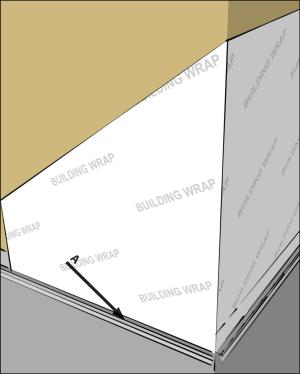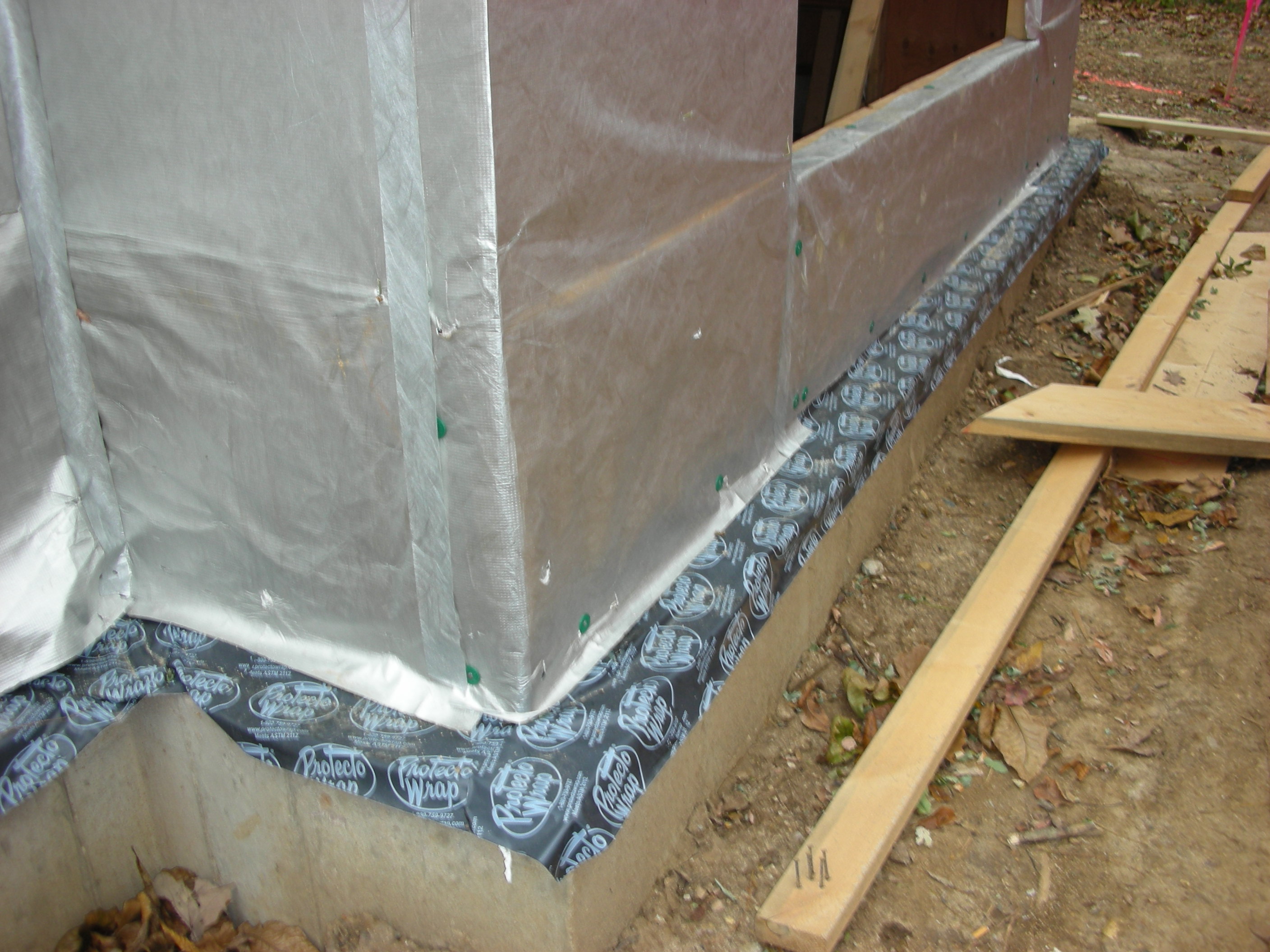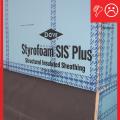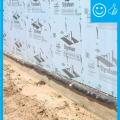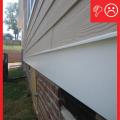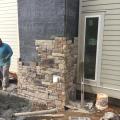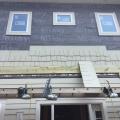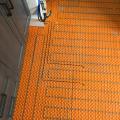Scope
Install flashing at bottom of all exterior walls and properly integrate the flashing with other wall water management details to direct water down and out of the wall.
- Install flashing under the bottom edge of the house wrap or other weather-resistant barrier shingle fashion to direct water out of the wall.
- Stucco cladding – install self-adhesive flashing behind the weep screed, a perforated metal strip at the base of the exterior walls, at the height above grade specified by the local building code. Install the water-resistant barrier to overlap the top edge of the weep screed. Install the lathe and stucco to the first bend in the weep screed.
- Brick veneer – install metal or flexible through-the-wall flashing that starts behind the bottom edge of the weather-resistant barrier and extends down and out across the support ledge then hangs down. Ensure that weep holes are included in the bottom course of brick to allow water to drip out and down the flashing. Install in brick walls at the base of walls, above all window and door lintels, and above shelf angles.
See the Compliance Tab for links to related codes and standards and voluntary federal energy-efficiency program requirements.
Description
Flashing at the bottom of exterior walls needs to be integrated into a continuous drainage plane on the exterior wall. The goal is to create a wall system that can manage the water that will inevitably get behind any cladding system.
Principles of a Water Managed Wall System
Water leaking through exterior cladding assemblies is a common cause of construction defects and call-backs.
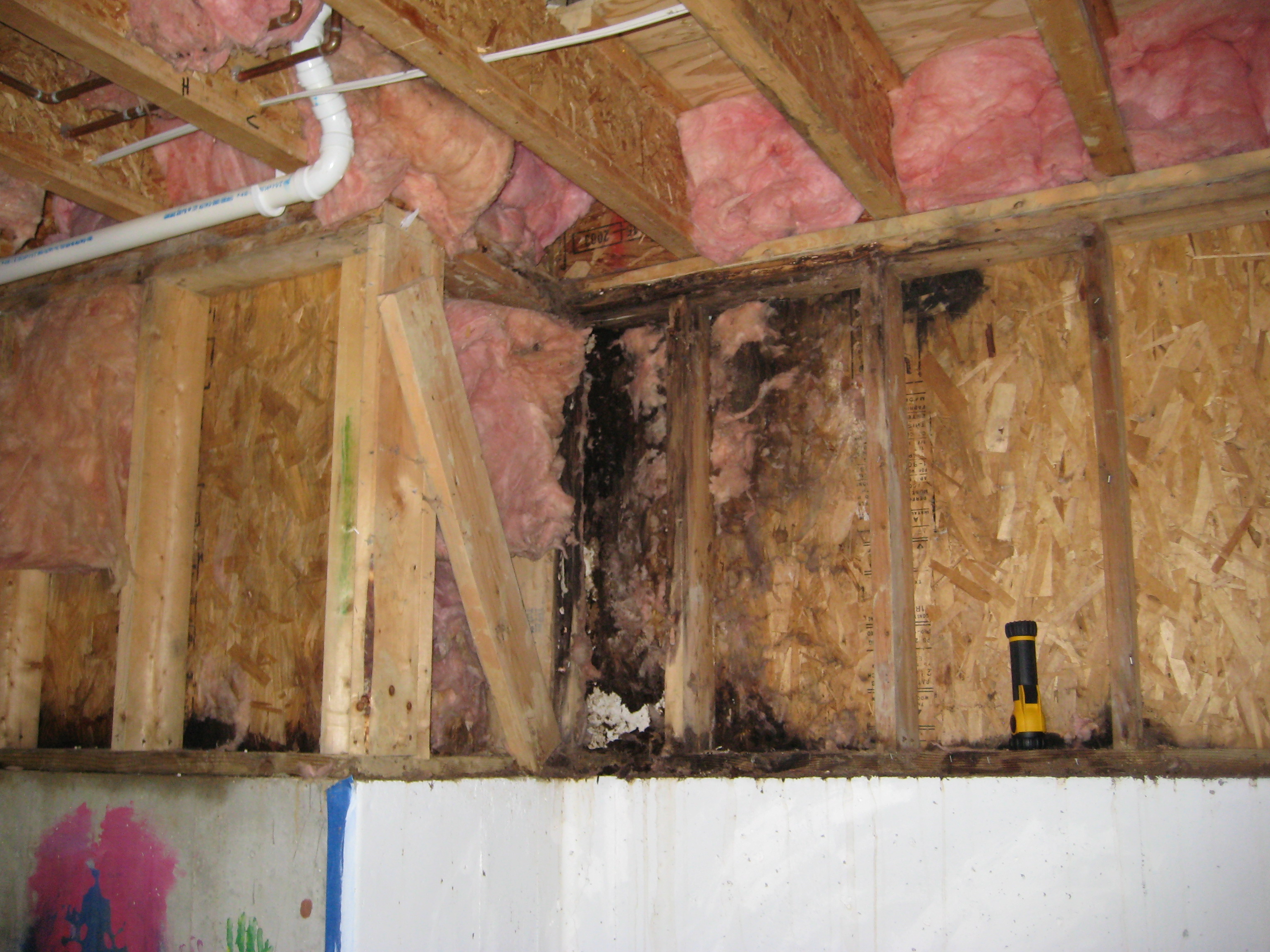
Typically, these wall leaks are caused by missing flashings or poorly executed flashing details at the following:
- roof-to-wall intersections
- penetrations
- windows and doors
- transitions between different claddings when more than one cladding is used at the bottoms of exterior walls where cladding systems interface with the foundation.
The key to eliminating costly leaks is more than just applying a piece of flashing. You need to create a functional wall assembly that:
- Deflects water away from sheathing, framing and floor-to-foundation intersections.
- Drains water as fast and freely as possible to prevent water from being trapped and absorbed by building components.
- Dries. Select building materials that allow the wall to dry out when it gets wet, and avoid materials that have the ability to trap moisture (BSC 2007).
Continuous Drainage Plane
Drainable wall assemblies integrate a weather-resistive barrier and flashing to properly drain water away from building components. The specific materials and installation methods depend on the cladding used on the building. House wrap and flashing must be properly integrated to create a continuous drainage plane. Note in Figure 2 that the flashing at the bottom of the wall is just one of a number of wall details that work in concert with each other to ensure water drains down and away from the building (Straube 2007).
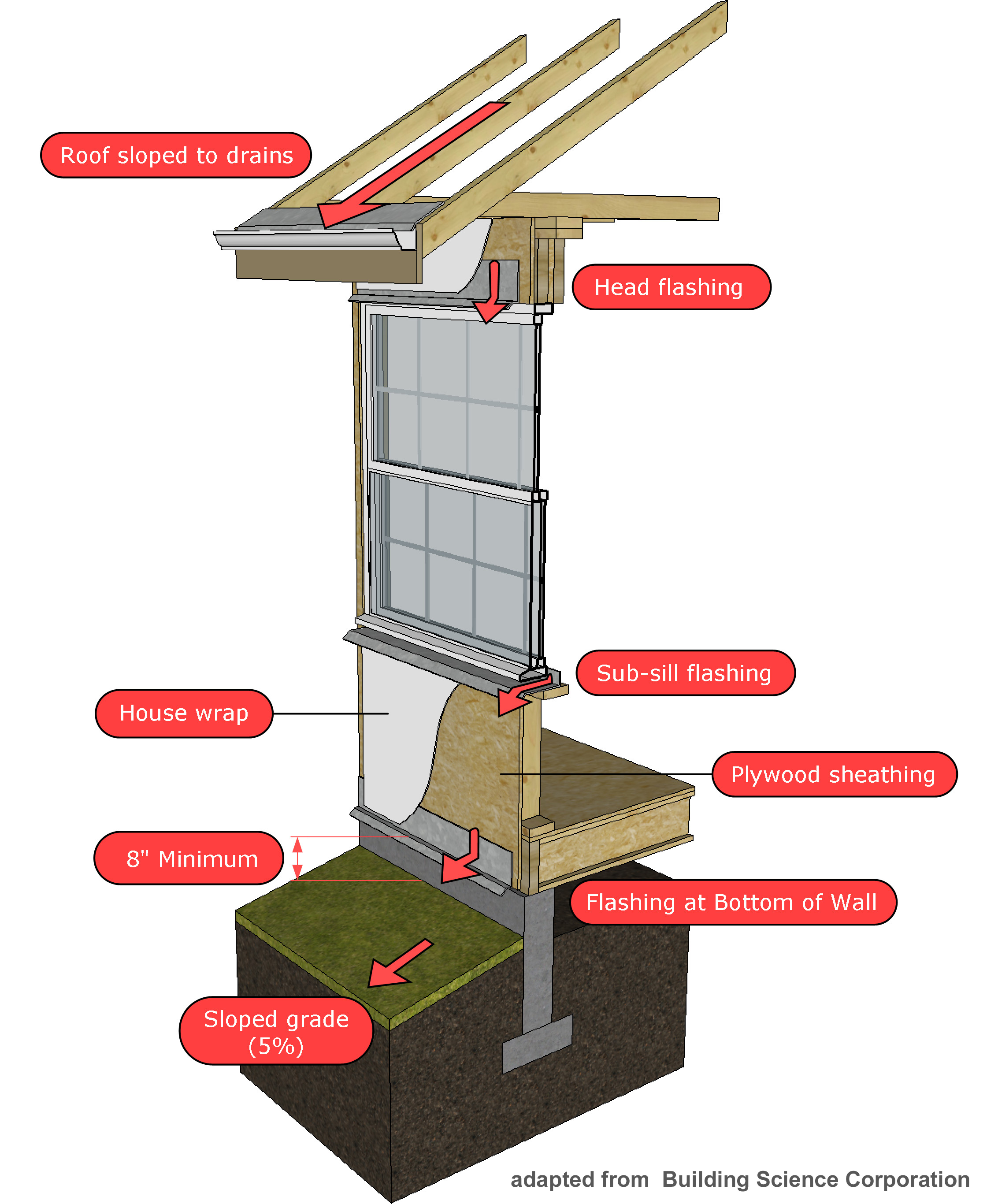
Installation Sequence
A continuous drainage plane is typically created using a weather-resistive barrier (WRB), such as building paper or housewrap. To work effectively, the weather-resistive barrier must be properly "shingled." Shingling is a term that describes the installation sequence that will allow water to drain away from the wall.
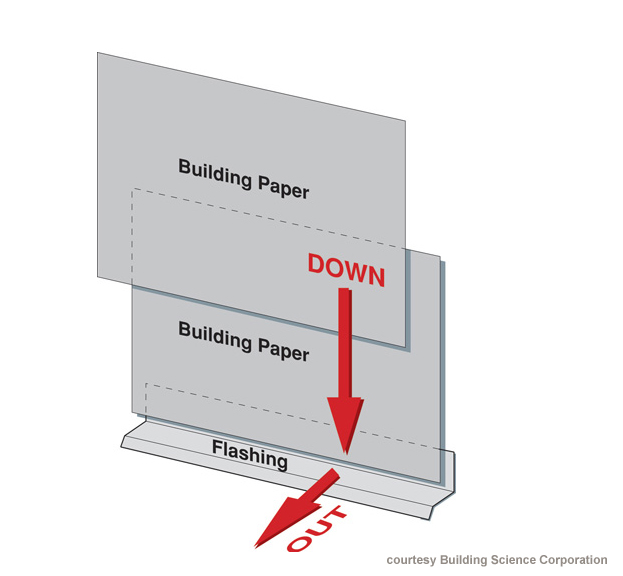
Figure 3 shows how the layers of the weather-resistive barrier must overlap to divert water out and away from the structure. In the sequence of construction, the flashing would need to be installed first. The bottom layer of building paper would be installed next, overlapping the vertical leg of the flashing. The top layer of building paper would be installed last (BSC 2007).
Rain screen wall systems also provide an air space between the wrap and the cladding. This air space helps reduce water problems in several ways.
- The larger space can create faster, unobstructed drainage.
- The space creates a capillary break to prevent water from wicking into building materials.
- The space allows for additional air movement to facilitate drying.
- The space can provide pressure moderation and help reduce pressure differentials that can help draw water into openings in the cladding.
- Helps prevent water vapor from the cladding from being driven into the wall assembly.
The air space varies depending on the cladding material. Wall venting behind brick and stone veneers is especially important. Under the right conditions, energy from the sun can push vapor through wet brick with the force of a steam boiler. A ventilation gap behind brick helps to dissipate this vapor before it is injected into the framed wall cavity. The gap should be 1 or more inches behind brick or stone veneer, 3/4 inch behind stucco, and 1/16 inch behind lap siding (Wrinkled house wrap will provide this 1/16-inch gap.)
How to Construct a Drainable Wall Assembly with Wood or Fiber-Cement Sided Walls
- Base flashing. Start by installing a metal or vinyl base flashing first. This piece should be applied directly to the wall sheathing using roofing nails. When more than one length is needed to span across the bottom of a wall, overlap pieces at least 8 inches. The flashing must include a drip-edge to direct any water that runs down the drainage plane away from the bottom of the wall.
- Weather-resistive barrier. Next, a weather-resistive barrier, such as building paper or house wrap, is applied to the wall, overlapping the base flashing. The example pictured in Figure 4 is a "drain wrap," which has a texture to it to facilitate drainage after the siding is applied over it. You don't need a drain wrap to create a drainable wall assembly, but the texture drains water faster than conventional smooth house wraps. There are several types of drain wrap: one type has a wrinkled surface; one type has plastic bumps that create a space between the wrap and the cladding (Smegal and Lstiburek 2012).
- 8-inch minimum between siding and grade. To prevent splash back from the roofline soaking the base of the wall, the bottom edge of the base flashing should be at least 8 inches above grade. This is a design detail that must be worked out before the foundation is poured. The grade must be sloped on all sides of the building so the water continues to drain away from the building. A 5% slope is recommended. This is a 5-inch drop per 100 feet, or about 5/8-inch per foot (Straube 2007).
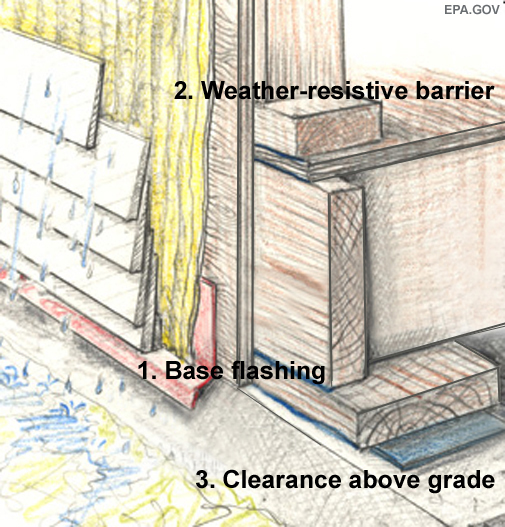
How to Construct a Drainable Wall Assembly with Stucco Clad Walls
Stucco is porous and will always crack. This is true even when installed perfectly. It is brittle, and cracking is in its nature. However, while these shortfalls will lead to water getting through the surface, the water can be managed. The key is to create a good drainage plane behind the stucco that drains to a weep system, allowing the water to flow out and away from the building.
- Self-adhesive flashing. When the weep screed attaches to plywood, OSB, or another wood-based framing material, a self-adhesive flashing membrane is needed first to protect the wood from water draining through the perforated screed (EPA 2015).
- Weep screed. Next, a weep screed is installed. The bottom edge of this piece of flashing should extend onto the foundation. The size of the screed will depend on the stucco thickness, with traditional three-coat stucco requiring a deeper profile than the screed needed for a one coat system. On an exterior insulation and finish (EIF) system, this flashing piece is called a weep channel, and it holds the bottom edge of the foam. It is perforated and works in principle just like a weep screed (EPA 2015).
- Two-layer weather resistive barrier. Most building codes require two-layers of building paper (or another type of weather-resistive barrier) beneath the stucco. The first layer (installed against the sheathing) serves as the drainage plane and protects the wall sheathing from water. The second layer works as a bond breaker. Wet stucco tends to adhere to building paper and house wrap. Water absorbed by the stucco will wick right through this bond breaking layer, but will drain down the wall between the two layers. Both layers should overlap the top edge of the weep screed (Lstiburek 2003).
- Lath. On wood framing, wire lath must be installed with the long dimension running perpendicular to the wall studs. Best practice calls for securing lath with furring nails, which place the lath in the center of the scratch coat (Note: Using paper-backed lath over a single-layer of house wrap or building paper will work as well as a two-layer weather resistive barrier and will save time) (DeKorne 2006).
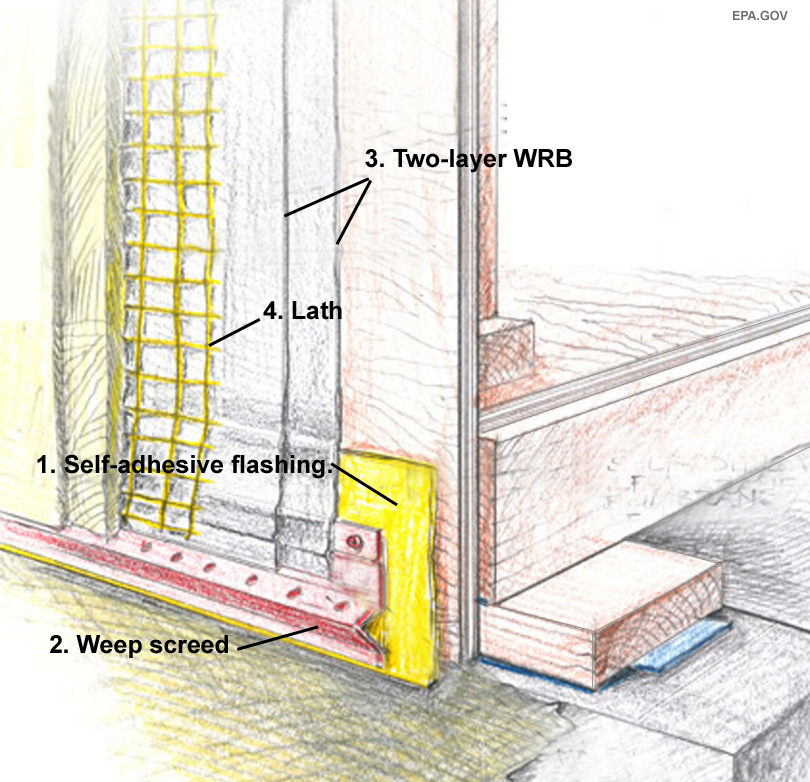
How to Construct a Drainable Wall Assembly with a Rain Screen Air Gap for Wood or Fiber-Cement Siding
Best practice with any wood or fiber-cement siding calls for building a rain screen assembly. This technique uses all the same water management details of a drainable wall assembly, but adds an air space behind the siding. This space creates a capillary break, which prevents water that wicks through the siding from being absorbed into the water-resistive barrier. The air space also allows air to flow freely behind the siding, which increases the wall's ability to dry.
- Base flashing. The wall system begins with flashing at the bottom of the wall, which collects water that drains down the wall and kicks it out at the base. Metal or PVC flashing can be used. It should have a drip edge that hangs below the sill plate, with the bottom edge at least 8 inches above grade (EPA 2015).
- Weather-resistive barrier. After the flashing, a weather-resistive barrier (WRB), such as building paper or a house wrap is installed to create a drainage plane. The first course of the WRB needs to overlap the vertical leg of the base flashing. Subsequent courses of the WRB must overlap the course below (EPA 2015).
- Furring. The air space is created by installing furring strips (vertical pieces of wood or plastic) spaced every 16-24 inches over the weather-resistive barrier. These need to be at least 3/8 inches thick. They can be ripped out of plywood or purchased precut from a lumberyard, and nailed every 12-16 inches with 5d galvanized nails (Hanley-Wood 2007).
- Insect screen. To block the entry of insects, install nylon screening. Tuck the screening behind the furring strips, wrap it around the ends of the strips, and pin it in place with the siding starter strip. Nylon is recommended, but other types of screening can be used, as long as it is an open mesh that will not block the free flow of air. Metal will rust and is not recommended (EPA 2015).
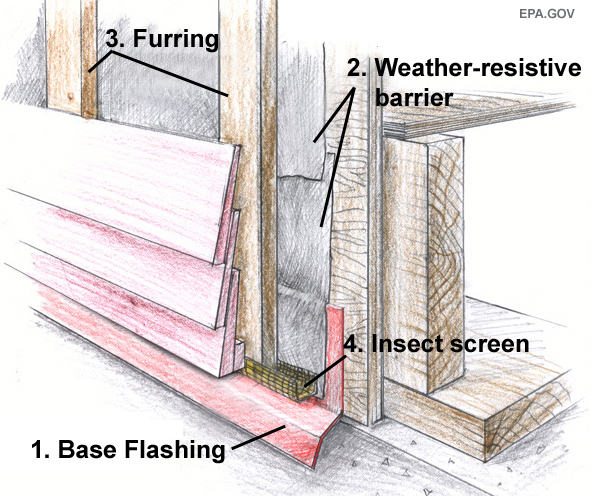
How to Construct a Drainable Wall Assembly with a Rain Screen Air Gap for Brick Veneer Siding
Properly detailed brick veneer functions like a rain screen. The key is making sure there is an unobstructed path for water to flow out at the bottom of the wall. This path starts with the airspace behind the brick. Water freely flows down through this space, gets collected by through-wall flashing at the bottom of the wall, and drains out through weep holes.
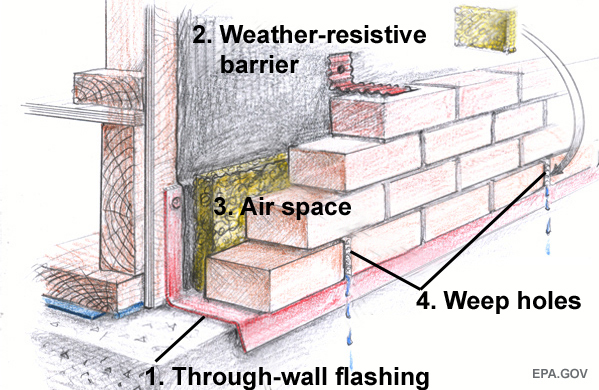
Through-wall flashing. The first step to detailing the base of a brick-veneer wall is to install a through-wall flashing, which extends down the sheathing and out across the support ledge (often a concrete extension of the foundation, but may also be formed with angle-iron).
Through-wall flashing can be made with metal, but is usually formed with a flexible rubber-based membrane, such as the one shown in Figure 8 (Hanley-Wood 2007).Figure 8. A flexible rubber through-wall flashing overlaps the bottom of the sheathing and works with the weather-resistant barrier to guide any water that gets past the brick down and out of the wall. - Weather-resistive barrier. Next, a weather-resistive barrier, such as building paper, must be applied over the framed wall assembly. The courses of the weather-resistive barrier must be applied "shingle fashion," with the lowest course applied first, overlapping the vertical leg of the through-wall flashing. The upper courses are installed afterwards, overlapping each lower course (EPA 2011).
- Air space. The brick must be installed with a 1-inch air space behind it to allow water that seeps into the brick to freely drain. The illustration above shows a mortar mesh installed in the air space at the base of wall. This helps to stop mortar droppings from clogging the weep holes (EPA 2011).
Weep holes. Water that collects on the through-wall flashing must be able to drain out through weep holes, which are formed by an "open" head joint (as shown in the illustration above), or with rope inserted into the mortar joint (as shown in the photo below). In this illustration the open head joints have been filled with an open-weave mesh. This is a good idea for keeping mud wasps from building their nests in the weep holes, and to prevent other obstructions from blocking the free flow of water (EPA 2012).
Figure 9. Rope is inserted in the head joist between the bricks in the lowest course of bricks to allow water to weep out of the base of the wall assembly.
Success
Builders and subcontractors should follow a protocol for water management details in exterior walls such as the ENERGY STAR Single-Family New Homes Water Management System Builder Checklist.
The project supervisor should inspect for flashing at the base of walls and at transitions between sidings before the siding is installed. This inspection should confirm that the weather-resistive barrier (WRB) overlaps the base flashings (EPA 2011).
Success with stucco
For wood-framed structures, hang the drywall before the lath and scratch coat are applied. Otherwise, the weight of the drywall will stress the wood framing, causing early settlement cracks, which can be acute if the drywall is hung before the scratch coat has had a chance to cure (DeKorne 2006).
Climate
The chief climate factor is exposure to rainfall. Buildings in regions with more rainfall are subject to increased incidence of water damage.
Drainable wall assemblies are recommended in all exposure regions. Rain-screen wall systems are considered best-practice upgrades in all exposure regions to ensure the long-term durability of building assemblies, but are especially recommended in High and Extreme exposure regions, as shown on the map below (BSC 2004).
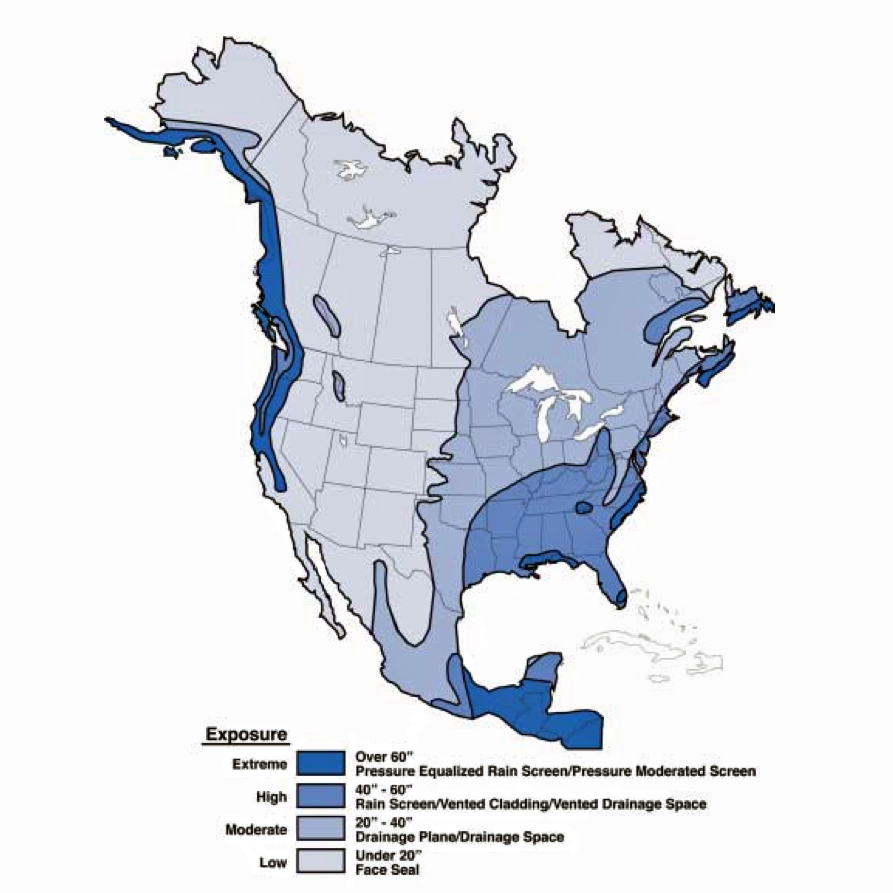
Figure 1. Average Annual Precipitation Map.
Training
Compliance
Retrofit
SCOPE
Retrofit existing exterior walls by adding base flashing to improve drainage, which mitigates water leaks and extends the life of the cladding.
- Remove cladding at the base of the wall and examine exposed building wrap, felt paper, or water control membrane, and sheathing beneath it.
- Repair torn or damaged building wrap as needed.
- If rotten sheathing is found, remove additional cladding as needed to diagnose and fix water damage, removing and replacing all rotten sheathing, installing new building wrap and flashing, and reinstalling cladding as needed
- Install base flashing as described in the Scope and Description tabs.
- If there is no separate water control membrane (fluid applied membrane, building paper, or felt) on the sheathing behind the cladding, tape or seal the top edge of the new flashing directly to the face of the existing sheathing with self-adhered membrane, sheathing tape, or sealant.
For more information on conditions that may be encountered when working with walls in existing homes, see the assessment guide on walls, windows, and doors.
See the U.S. Department of Energy’s Standard Work Specifications for more on sealing walls to keep out moisture, air, and pests. Follow safe work practices as described in the Standard Work Specifications.
DESCRIPTION
Existing exterior walls may be retrofitted to add flashing at their base to improve water management, reduce staining, and extend the life of the cladding. As with new construction, the goal is to direct water that passes behind the cladding and reaches the house’s water control layer downward and out, away from the building. (See Figure 3 in the Description tab for an illustration of the conceptual approach.)
Retrofitting to add base flashing involves removing a portion of the cladding at the bottom of exterior walls. This tends to be easiest with lap or panel siding cladding types that can be removed and re-installed by unscrewing fasteners, and most difficult with brick and stucco claddings that require materials to be chipped out and replaced. Unflashed reservoir cladding systems (those that absorb water) such as brick and stucco, however, tend to be responsible for the worst water damage (staining, leaks, and freeze-thaw). See Figure 1.
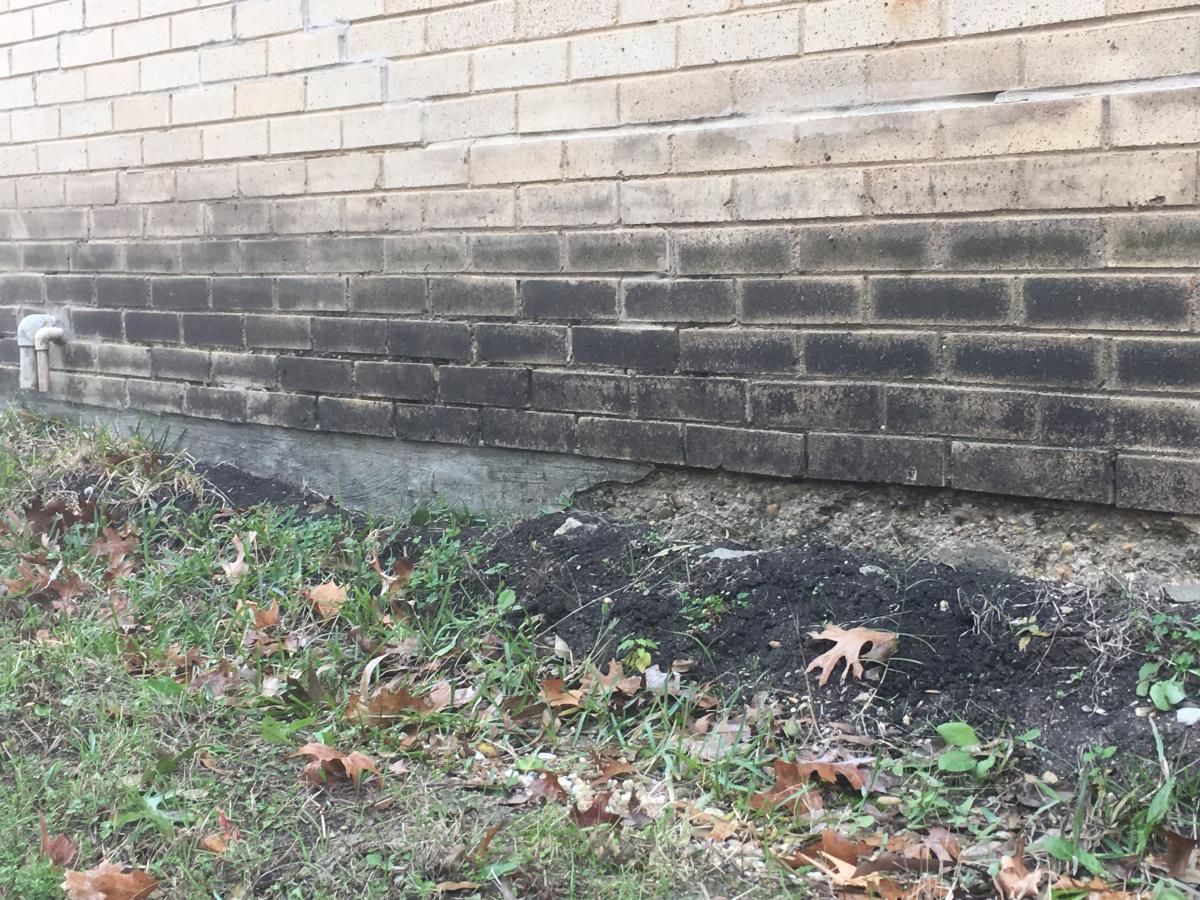
For a successful base flashing retrofit, the extent of the removal of the existing cladding need only be whatever is sufficient to strip-in the new metal or rigid plastic flashing with the water control layer behind the cladding (see Scope). However, if upon removal of the cladding, rotten sheathing is discovered, additional removal is recommended to remove and replace all rotten sheathing and mitigate the cause of the damage. Brick claddings do not differ from other cladding systems in that the extent of the removal can be limited to only what is required to add the new flashing; however, this may be an excellent time to consider repointing the mortar at the base of the wall. Look to the existing pattern of staining and damage for an indication of where to repoint. When the brick is replaced, weeps should also be added to the mortar joints. See Figure 7 in the Description Tab.
How to Add Flashing to the Base of an Existing Wall
- Remove a portion of the cladding at the base of the wall and examine the condition of the exposed building wrap, felt paper, or water control membrane, as well as the sheathing beneath it.
- Repair torn or otherwise damaged building wrap as needed.
- Assess the condition of the sheathing. Damp sheathing will dry with improved drainage, but rotting sheathing should be removed and replaced. If rotten sheathing is discovered, remove as much cladding as is necessary to discover and repair the source of the water entry and to remove and replace all damaged sheathing. Install new flashing and weather-resistant barrier (fluid applied membrane, building paper, or felt) as needed.
- After the cladding has been temporarily removed at the base of the wall and if the sheathing is sound (or after damaged sheathing has been repaired), follow the guidance in the Scope and Description tabs to install new base flashing.
- If there is no separate water control membrane on the sheathing behind the cladding, tape or seal the top edge of the new flashing directly to the face of the existing sheathing with self-adhered membrane, sheathing tape, or sealant. Follow the substrate preparation instructions of the membrane, tape, or sealant manufacturer to ensure proper long-term adhesion.
COMPLIANCE
See Compliance tab.
More
More Info.
Access to some references may require purchase from the publisher. While we continually update our database, links may have changed since posting. Please contact our webmaster if you find broken links.
The following authors and organizations contributed to the content in this Guide.
Building Science Corporation, lead for the Building Science Consortium (BSC), a DOE Building America Research Team
The U.S. Environmental Protection Agency.
Sales
Water Managed Walls = Wall Moisture Control System
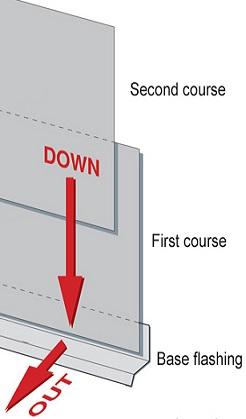
Most exterior wall cladding systems leak. Wind pressure and capillary action can drive rainwater through the many cracks, joints, and small gaps in a building's exterior. With typical residential siding systems, it is nearly impossible to seal all those holes. Even if a builder succeeds in sealing a majority of the holes, using caulk on the exterior of the wall is not a long-term solution; the caulk will need to be reapplied fairly often. A more practical way to protect building exteriors from rainwater relies on a drainage approach. With this approach, any water that leaks through the cladding will run into a water-resistant surface and safely drain down and out of the wall. The water-resistant surface could be house wrap or rigid foam that is securely taped or sealed at all seams. . House wrap should be lapped over any exterior wall flashings installed around window and door openings or where roofs intersect walls. Any holes through the wall, such as for water spigots, exhaust vent outlets, HVAC line sets, or wiring for outdoor light fixtures and receptacles, should be carefully sealed or gasketed.
